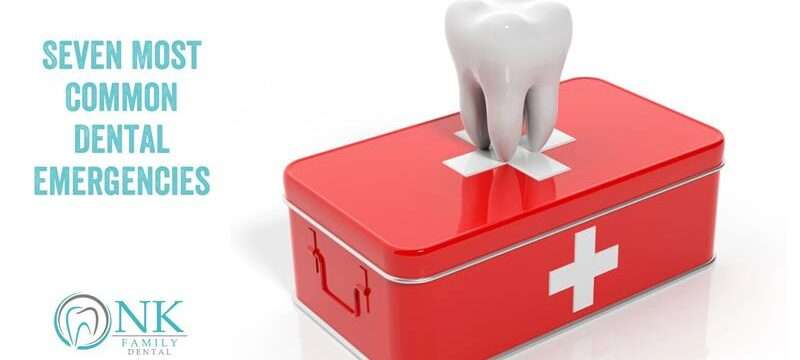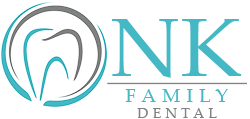
If you practice good oral hygiene and visit your dentist twice a year for a dental examination and cleaning, you probably don’t expect anything out-of-the-ordinary to happen to your teeth or gums. But unfortunately, emergencies can still occur. We’ll look at the seven most common that lead to an unintended trip to your dentist for immediate treatment.
1. Toothache
Almost everyone has experienced a toothache at some time. Dental pain typically originates from one of the following causes — some of which we’ll cover individually in this blog post:
- Tooth decay (cavities).
- Abscessed tooth.
- Cracked tooth.
- A damaged dental restoration (like a filling, crown or bridge).
- Teeth grinding or clenching (bruxism) during sleep.
- Periodontal (gum) disease.
Tooth pain becomes a dental emergency when it’s severe, persistent, or accompanied by other serious symptoms like swelling, fever, or trouble breathing or swallowing. If the pain is intense enough to disrupt daily activities and/or any of the aforementioned symptoms are present, it’s crucial to seek immediate dental treatment. If the tooth is infected and left untreated, you could develop sepsis — a life-threatening infection that spreads throughout the body.
Keep in mind that other than sensitivity to food/beverage temperatures, no type of dental pain is normal. Schedule an appointment with your dentist, even if the pain is dull and intermittent, as it can escalate without warning. Finding and treating the cause early on can help prevent it from becoming an emergency that’s even more painful, and may be too far advanced to save the tooth and/or prevent sepsis.
2. Chipped or Broken Teeth
A damaged tooth is typically the result of trauma. Biting down on ice, hard candy and shelled nuts can cause serious damage — as can using your teeth as a tool (such as a bottle opener). Bruxism can be another cause. A tooth cracked down to the gumline is an emergency, as is any tooth injury that results in loss of tooth structure, exposure of the pulp, and/or severe, ongoing pain. A minor chip to the enamel that doesn’t cause pain isn’t an emergency, but needs attention sooner rather than later, as the tooth’s integrity has been compromised — making it more vulnerable to further damage or decay.
3. Knocked-out Tooth
Medically known as an avulsed tooth, this is typically the result of a sports injury or other traumatic event. However, if the circumstances are right, the tooth has been handled properly and you reach the dentist in time, there is a possibility that it can be successfully reimplanted. Our blog post — “So You Lost a Tooth! How to Handle Accidental Tooth Loss” — covers this topic in greater detail.
To increase the probability of reimplantation, take the following actions immediately after the tooth is knocked out:
- Don’t touch the root, only the crown.
- Try to place it back in the socket, if possible, or place it between your cheek and gum or a container of milk.
- Use a cold, wet compress for bleeding.
- Call the dentist on the way to his/her office if the injury occurs during office hours. This will give your dentist time to prepare so you can be treated without delay when you arrive.
Should the dentist be able to reimplant the tooth, it will be reinserted into the socket and splinted to the adjacent teeth to keep it from moving. In some cases, the dentist will perform an immediate root canal to remove the nerve of the tooth and replace it with plastic material so as to prevent infection and further dental procedures.
If the tooth cannot be retrieved or reimplanted, the socket will be treated to clean it out and prevent infection. After healing is complete, a restoration such as a dental implant or bridge may be recommended.
For those who participate in contact sports, we strongly recommend using a mouthguard to prevent this type of injury.
4. Lost Filling or Crown
A filling that falls out or is knocked out due to trauma is an emergency when it’s a restoration to a molar. Not only is this painful, it leaves the center of the tooth exposed to infection. The loss of a small filling on the outer surface of a tooth may be unaesthetic, but can wait a few days for a scheduled appointment with your dentist.
The loss of a crown isn’t always an emergency. Again, it depends upon the location of the crown and circumstance of how it was damaged. As the tooth under a dental crown is very small and not particularly functional on its own, you may not be able to chew, bite, speak — or smile — properly. If the crown falls off on its own and is intact, it may not be able to be put back in place. It’s more likely you’ll need a new restoration.
You may experience pain after losing a filling or crown. This can happen due to exposed nerves inside the affected tooth. You can use over-the-counter pain medicines to provide short-term relief from minor or more severe discomfort.
5. Abscessed Tooth
A tooth abscess is a pocket of pus from a bacterial infection. Abscesses can occur in different places around a tooth for different reasons and affect not only the involved tooth, but also the surrounding bone and adjacent teeth. Call your dentist as soon as possible, as you could develop sepsis. Those with a weakened immune system are at even greater risk.
The main symptom is a severe, continuous toothache that can be described as gnawing, sharp, shooting, or throbbing. An abscess will not spontaneously resolve. Attempting to treat it yourself with home remedies will only allow it to spread, and endanger your health — and even life — by delaying medical treatment. Our blog post — “What Causes a Tooth Abscess?” — covers this topic in greater detail.
6. Broken Orthodontic Appliance
Traditional metal-and-wire braces are constructed to sustain wear-and-tear, but can break. The most common issues are a broken wire, broken bracket or a spacer that has fallen out. This can be caused by biting into hard food, trauma to the mouth, or just normal wear. A broken or loose wire is the most common orthodontic emergency. It can cause discomfort and pain, and even lead to further damage if not treated promptly.
If you experience a broken wire, schedule an appointment with your orthodontist as soon as possible. In the meantime, you can use orthodontic wax to cover any sharp ends of the wire to prevent it from irritating your cheeks or gums. Be careful when eating, and avoid hard or sticky foods that can exacerbate the problem.
Likewise, a broken bracket requires immediate attention. A loose bracket can cause discomfort and can even damage the surrounding teeth and soft tissues. To reduce discomfort and the risk of further damage, try to gently push the bracket back into place using a clean finger or the eraser end of a pencil. If this is not something you can do, you can cover the bracket with dental wax to protect the surrounding tissues from irritation. Avoid hard and sticky foods; rinse your mouth with warm saltwater to soothe any discomfort and keep your mouth clean.
A lost spacer can cause discomfort or pain. Contact your orthodontist as soon as possible. In some cases, you may be advised to use orthodontic wax to temporarily fill the space until you can be seen. If left untreated, it could potentially impact your treatment progress and cause further complications.
7. Bleeding and Pain After a Tooth Extraction
Some amount of bleeding is normal in the hours immediately after a tooth extraction. However, persistent bleeding and pain that isn’t managed by the pain medication prescribed to be taken after the procedure are not. The most frequent reason for prolonged bleeding is the dislodgement of the blood clot that forms in the socket after extraction — which also results in pain. This can be caused by the following:
Vigorous rinsing or spitting — These actions create pressure that can dislodge the clot.
Sucking through a straw or smoking — These create suction that can pull the clot out.
Touching the extraction site — Using your tongue, fingers, or other objects to probe the area can disrupt the clot.
Medications — Certain medications — especially blood thinners (anticoagulants) like warfarin, aspirin, or clopidogrel — can impair the body’s ability to form clots, leading to prolonged bleeding.
Underlying medical conditions — Conditions such as hemophilia, Von Willebrand disease, liver disease, or vitamin K deficiency can affect blood clotting and increase the risk of bleeding.
Infection — Infections in the extraction site can interfere with the healing process and cause bleeding.
Trauma to the site — Accidental injury to the extraction site, such as biting down on hard foods, can also disrupt the clot.
Call your dentist or oral surgeon immediately if the following occurs:
- Bleeding is excessive and doesn’t slow down, or continues for more than 24 hours.
- There is increased pain, swelling, or pus; these may be signs of infection.
- Signs of excessive bleeding and potential complications — such as dizziness or lightheadedness.
The Take-Home Message
Although we’ve called these seven dental emergencies “common,” they aren’t common when they happen to you. Also, calling them “common” doesn’t minimize their seriousness. Our blog post — “What is a Dental Emergency?” — provides additional information.
While some dental emergencies may not be able to be prevented, most can be by regularly practicing good oral hygiene and scheduling twice-yearly examinations and cleanings with your dentist, who will find early indications of dental decay, periodontal disease or other conditions so they can be treated in a timely manner.
At NK Family Dental, it is our mission to provide the highest quality and most compassionate oral care to our Chicago patients, including both dental and periodontal services. Our practice is trusted for advanced oral surgery procedures and comfortable root canal treatment.
Our team of experienced, dedicated dental professionals will help address your oral health concerns, and determine the best solution for you based on your individual situation. We strive to identify treatment options that fit your needs.
Our dental specialists include our general dentist, Dr. Nilofer Khan, our endodontist, Dr. Sabek, and our periodontist, Dr. Amir Danesh. Dr. Danesh is a board-certified periodontist and Diplomat of the American Board of Periodontology. He has contributed to the publication of two books, as well as published over 20 papers in prestigious dental research journals.
We serve the neighborhoods of Logan Square, Bucktown, Humboldt Park, and Wicker Park with the dedication that’s earned us the reputation as the Best Dentist in Chicago!
We understand that the main concern you may have is cost, which is why we accept all major PPO plans for dental insurance and also offer our in-house dental plan. Please see our financing page for more information.
Schedule your visit through ZocDoc, or contact us directly. We look forward to treating you soon!
